Silk Bridesmaid Dresses Biography
Source(google.com.pk)
The wedding gown is unique. Along with baptism and burial, marriage is one of the three great public occasions in a person's life, and the only one at which the principals can fully appreciate the glory of their central role. For the bride, more than the groom, it is Her Big Day. Throughout history, women have tried to make their wedding dress special, to suit the festive occasion, to make the beautiful bride more beautiful and the not so beautiful at least splendid to look at.
At the top of the scale, royal princesses have always tried to be most princess-like on their wedding days. In medieval times, when royal marriages were of great political importance and used to seal alliances between two countries, it was also necessary for the young bride to look magnificent to uphold the prestige of her country, to impress the bridegroom's country with her own nation's apparent wealth and, if possible outdo anything they could have afforded. Her jewellery might well have been the topic of prolonged negotiation, as part of her dowry.
To this end they used as much material as they possibly could, of the most costly, like velvet,damask silk, satin, fur and fabrics woven with gold and silver thread. In days when all fabrics were hand spun, woven and dyed, and economical use of it was the norm, the skirts would be gathered and full, the sleeves would sweep the floor and trains would fall behind to a length of several metres. Colours would be rich too - only the wealthy could afford expensive red, purple and true black dyes, which were much harder to acquire than natural vegetable-based shades. Additionally, the dress would be sewn with precious gems - diamonds, rubies, sapphires, emeralds and pearls - so the bride would glitter and flash in the sunlight. In some cases, the gown would be so thickly encrusted with jewels, that the fabric beneath was hidden and in the fifteenth century when Margaret of Flanders was married, the result was so heavy that she could not move in her robes and had to be carried into the church by two gentlemen attendants!
With the advent of constitutional monarchy, royal marriages were of dynastic, rather than national importance, but a princess going, or from, overseas would still wish to impress her new country. This sometimes backfired, when an outfit in the height of current style at her own court might not be so admired elsewhere. This happened to poor Catherine of Braganza (left) at her wedding to Charles II of Britain in 1662, when her pink farthingale was castigated as dowdy, and her hairstyle as peculiar.
Of course, not many brides were princesses and most could not afford such expense. But, in order to look special, a bride would usually try to copy the dress of a woman of a higher social class than herself. A noblewoman would do her best with gems and fur trimmings. A well-to-do middle class woman (like Giovanna Cenami in 1434, right) would aspire to velvet or silk fabrics, and because she could not usually afford mink or sable, she would wear fox, or rabbit fur to impress her friends. The poor bride's dress would be of linen, or fine wool, instead of the usual coarse homespun, and she would use as much fabric as she could. For an everyday girl, clothes would normally be as sparingly cut as was decent, so a gown with flowing sleeves or a train was a big status symbol. In modern times with factory made materials, the symbol of the bride in her train has lost its original meaning, but become a tradition.
An ordinary girl, who could not afford very much in the way of decoration or trimming on her wedding outfit, which would have to become her Sunday best frock immediately afterwards, and maybe serve for many years as part of her everyday wardrobe, still wanted the excitement of a special dress. She could have it by adhering to the rules and traditions of wedding costume.
Before modern medicine, a long and healthy life was not very easy to achieve, but people tried to ensure good luck by following superstition. Many superstitions grew up around weddings, to bring about a girl's happiness in her new home and of course to guarantee her fertility. The colour of the gown was a popular source of luck.
White, or a variation of white, was of course always a favourite and symbolised a girl's virginity and innocence in the face of her imminent change of state. But it was not a practical shade for most purposes and it was not always the favourite choice. Blue (as worn by a bride of 1870, left, whose gown is in the London Museum), with its associations with the Virgin Mary, was another a strong symbol of purity, which also traditionally symbolised fidelity and eternal love (hence the popularity of the sapphire in engagement rings). Brides who wore blue believed their husbands would always be true to them, so even if their gown itself was not blue, they would be sure to wear something blue about their person. This is another tradition that has survived to this day.
Pink was another popular colour, considered most suitable for a May wedding. It is flattering to most complexions and associated with girlhood, but some superstitions held it to be unlucky - "Marry in pink and your fortunes will sink"! Mrs Joseph Nollekens (right) was much admired in 1772 in her saque gown of brocaded white silk embroidered with delicate pink flowers. She wore shoes of the same material, with heels of three and a half inches (8cm). The deeper shade of red was definitely taboo by Victorian times, with its reference to scarlet women and hussies.
Amongst the unpopular shades was green. This was considered the fairies' colour, and it was bad luck to call the attention of the little folk to oneself during a time of transition. Also linked with the lushness of verdent foliage, it was held to make rain spoil the big day.
Harking back to the days of homespun garments, any natural shade of brown or beige was considered very rustic. "Marry in brown you will live out of town" with the implication that you will be a hick and never make good in the city.
The bright shade of yellow has had varied popularity. In the eighteenth century it was THE trendy colour for a while, and many wore it, like this bride of around 1774 (left) whose dress is at the Gallery of English Costume in Manchester, but before that time it had been associated with heathens and non Christians and was considered an unholy shade to wear in church!
or brides of the lower classes, an extremely common shade of wedding gown was grey, because it was such a useful colour to re-use as Sunday best, being considered eminently respectable. Mary Brownfield (right) chose grey twilled silk as suitable, as a maiden lady of 32 years at the time of her marriage in 1842. In Victorian times it became associated with girls in domestic service, as they would often be provided with a new grey dress each year by their employer. Its deeper shade of black was of course banned, with its permanent association with death and mourning. In fact it was considered such a bad omen that in some places even the guests were not allowed to wear it, and a recent widow would change her mourning for a red gown for the day, in deference to the bride. This in turn deepened the antipathy towards red, which was viewed as bridal mourning.
Those forced by economics into wearing a dress that would soon become regular daily wear, would adorn it for the day with temporary decorations. Up until the nineteenth century ribbons would be tied into bows, or "love knots" and loosely attached to the dress. These "bride laces" would be pulled off by the guests during the post ceremony festivities, and kept as wedding favours, or souvenirs. This custom gradually died out, being replaced by flowers instead. Guests would be given floral button-holes to wear, and the bride might wear flowers in her hair; as a corsage; or garlanded round her skirts, or else carry them in a bouquet. Rosemary and myrtle were early favourites, and orange blossom became popular in the 1830s. This custom has, of course, remained to this day - most brides, no matter how simply dressed, will have a flower or two somewhere on their outfit! When Charlotte Pennell (left) married George Hill in 1910, she was nearing 40, and had no intention of wearing a "once only" dress. She did however, decorate her fashionable ensemble with a posy of flowers in her hat and a matching bouquet.
The "traditional" wedding garb as we know it today first appeared in the late eighteenth century. With the introduction of machine made fabrics and cheap muslins imported from India, and styles inspired by the classical world, by 1800 the white dress with a veil was definitely the one to wear. As usual with fashion, it began in London, spread to other cities and towns and eventually to country areas. Princess Charlotte (right) gave it royal approval at her marriage to Prince Leopold of Saxe-Coburg in 1816. In 1840 Queen Victoria (left) chose white silk and Honiton lace for her own wedding, and made it the virtual rule.The Queen was the first royal bride to have bridesmaids to carry her train too, which also set a fashion.
In the nineteenth century, even a bride who wore white would expect to wear her dress again. For the season of her "bride visits" when she would do the rounds of family, friends and acquaintances as a newly married woman, she would wear her bridal gown, with the train and flowers removed. A higher class bride would then adapt the bodice of the outfit (which was often made separately) and retrim it for evening wear for another season. Queen Victoria herself removed the lace overskirt from her dress and frequently used it again - she wore it over a black silk gown for her Diamond Jubilee celebrations over 50 years later.
Until the 1920s wedding dresses were always in the style of the moment, if more elaborately decorated than usual, and more modest than the the most daring fashion. In that decade however, there was a revolution in women's clothing, and hemlines for ordinary wear rose from the shoe to well above the knee. At first wedding styles followed suit, and brides showed their ankles, but as skirts grew ever more abbreviated, it was felt by some to be unsuitable for a church service, and many brides preferred full-length wedding gowns. This choice of following the fashion of the season or reverting to a long dress with a train led in the twentieth century to the development of a separate style in bridal wear which echoed, but often diverged from mainstream fashion (like this Vionnet couture design of 1926).
This was emphasised by the hiatus caused by the Second World War, when clothes were rationed, uniforms were ubiquitous, and frivolity was frowned upon. When fashion came back, everyone was keen to wear long gowns in luxurious fabrics on their wedding day, regardless of the ever increasing popularity of casual, easywear clothing and trousers for women in daily life. As fashion has become more relaxed and sporty, so wedding styles have diverged more, so that although each decade's brides are easily distinguished by the styles then in vogue, it is not because of that style's resemblence to general fashion.
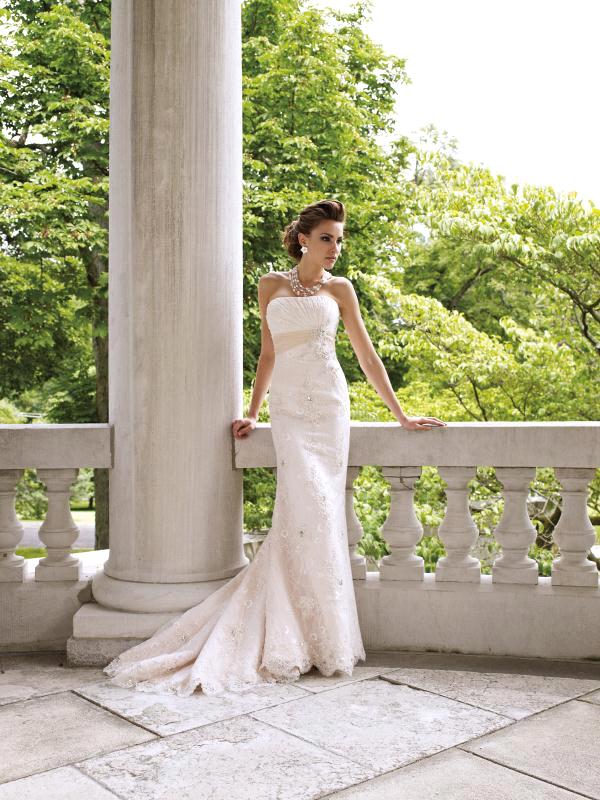
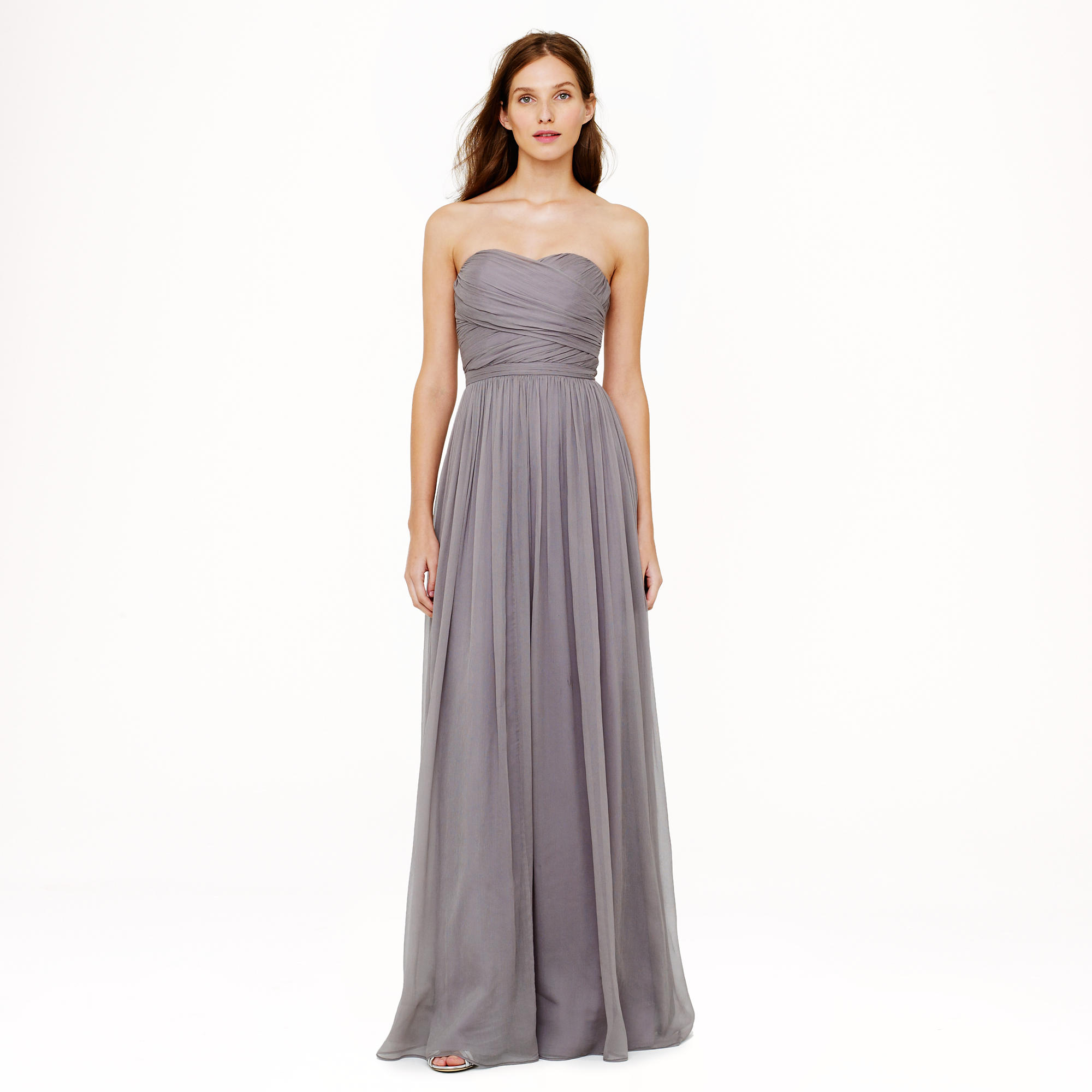

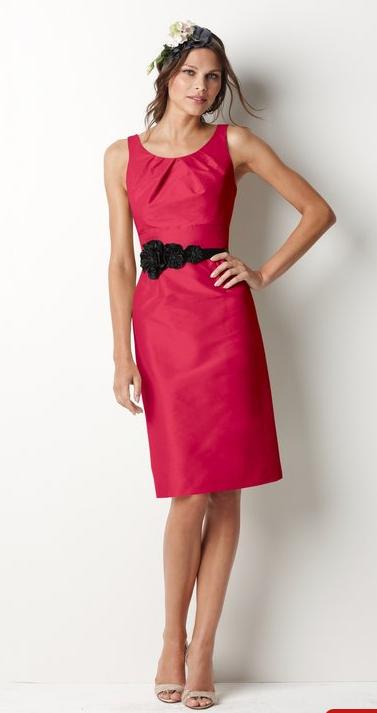


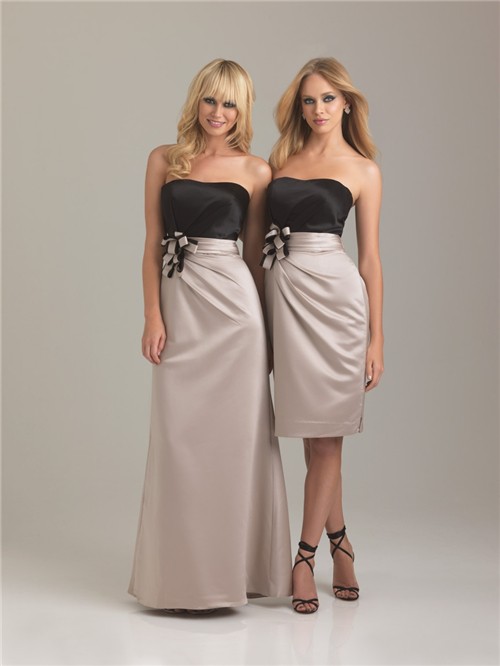
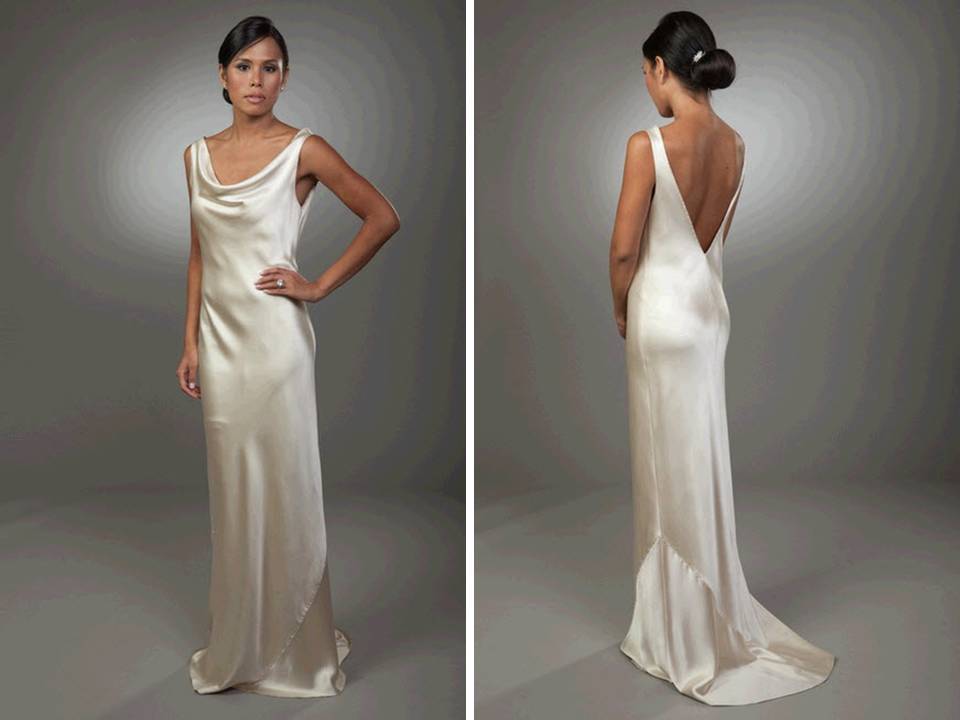
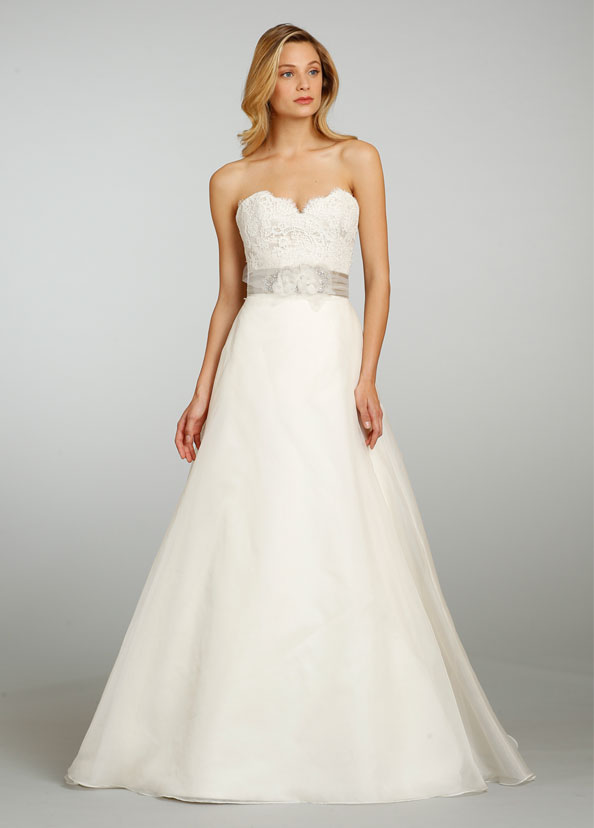

No comments:
Post a Comment